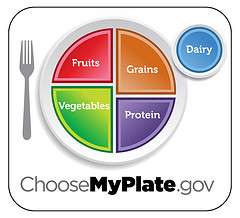Probing Question: Why the USDA changed its nutritional guidelines

First Lady Michelle Obama may be remembered for toppling a pyramid. A food pyramid, that is -- the longstanding icon of the USDA’s official nutritional recommendations for the American public.
Since 1992, the food pyramid has been recognized -- if not embraced -- as the government’s visual reminder about healthful eating practices. “The main criticism,” said Terry Hartman, associate professor of nutrition at Penn State, “was that it was too complicated, and some perceived it as outdated.”
Taking its place as a teaching tool about nutrition? The less majestic (but perhaps more meaningful) symbol of a simple dinner plate.
A panel headed by Michelle Obama, Agriculture Secretary Tom Vilsack and Surgeon General Regina M. Benjamin introduced the new MyPlate nutrition symbol in early June 2011 in Washington. Said Hartman, “MyPlate is meant to be a simple reminder to guide people to healthier choices. The USDA has set up a new website ChooseMyPlate.gov, with tools and resources to help consumers decide what to eat.”
Critics of the pyramid had long believed it difficult to understand at a quick glance, particularly since children are a primary audience. Some nutritionists also decried it as giving misleading nutritional advice, noting that the graph didn’t distinguish between dangerous and heart-healthy fats or lean versus fatty protein sources, and didn’t provide guidance about portion control.
As Mrs. Obama put it when she unveiled the new symbol, “We’re all bombarded with so many dietary messages that it’s hard to find time to sort through all this information, but we do have time to take a look at our kids’ plates.”
Regarding how to use the new plate image, the First Lady added that if your filled plate looks like the symbol, with lots of fruits and vegetables, “then we’re good, it’s as simple as that.” Hartman echoes that sentiment. “The USDA is trying to send several messages with MyPlate. They are encouraging people to manage their portion sizes to avoid consuming too much energy in the form of calories. Half of the foods we consume should be fruits and vegetables.”
The message may seem very simple -- but the consequences of not following it have unleashed a complex national health crisis. With more than 62 percent of Americans currently obese or overweight and rates trending upward each year, the success or failure of a nutritional public health campaign has never seemed more vital.
“The role of food choices in maintaining a healthy weight can’t be overestimated,” said Hartman, adding that obesity puts people at greater risk for potentially life-threatening conditions such as heart disease, diabetes and cancer.
The MyPlate program and educational materials were created by the Agriculture Department with advice from federal health officials and the First Lady’s anti-obesity team, and involved focus groups with about 4,500 people, including children, in the development phases. Proponents call the expense of developing MyPlate -- about $2 million -- a drop in the bucket compared to the personal and financial cost of obesity-related illnesses. Do government dietary guidelines matter at all? Yes, believes Hartman. “These nutrition guidelines not only help individuals to make choices but also provide guidance to school lunch programs, feeding programs for older adults, the food industry and others.”
In the end, the proof of the pudding (make that a small portion of low-fat pudding) may be whether the plate does a better job than the pyramid in turning Americans away from sugar- and fat-laden “empty calories” and toward healthier food choices.
“It’ll take some years before we know if this new campaign is helping us reverse course and slim down, as a nation,” said Hartman. “Let’s hope MyPlate helps get this important message across.

















